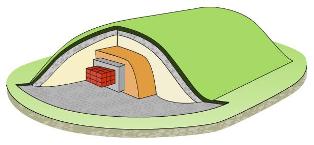Contract for Ignalina waste repository
02 November 2009
A consortium led by France's Areva has been awarded a contract to design a near-surface repository for low- and intermediate-level waste (LLW/ILW) at Lithuania's Ignalina nuclear power plant.
 |
| The concept of the new LLW/ILW repository (Image: Rata) |
The repository will accommodate the LLW/ILW resulting from the operation and decommissioning of Ignalina. It will be built according to the same concept as the CSFMA, a French LLW/ILW disposal facility in Soulaines-Dhuys, Aube District, which has been operated by the French national radioactive waste management agency Andra since 1992.
The project, which is being funded primarily by the European Bank for Reconstruction and Development (EBRD), includes the design studies for the repository and on-site support during construction.
Apart from Areva, the consortium comprises Andra and three Lithuanian partners: the Lithuanian Energy Institute, Specialus Montazas-NTP and Pramprojektas.
A concept of the LLW/ILW disposal facility has been developed and approved by regulating authorities in Lithuania. According to this concept, it is planned to construct a reinforced concrete repository of the celled type, which will contain some 50 sections designed for the final disposal of about 100,000 cubic metres of radioactive waste packed in concrete containers and immobilized in the cement matrix. The repository, its protection zones and auxiliary structures will occupy an area of some 40 hectares at a site at Stabatiske, very close to the Ignalina plant.
Wastes will be placed in the repository through to around 2030, when dismantling of the Ignalina reactors and processing of all the radioactive waste is expected to be completed. The repository will then be closed and its surface covered with corrosion-resistant, multilayer protective engineered barriers. The repository will then be monitored for at least 300 years.
The wastes themselves will primarily be contaminated equipment and disposable clothing from the operation the two reactors at Ignalina. When the power plant itself is decommissioned over coming decades most of the resulting wastes would at be low- and intermediate-level and would also be stored in the new facility. This waste would typically be concrete rubble, used filters and piping that had been closer to the nuclear reaction processes. As short-lived waste it would lose almost all of its radioactivity over a few years to a few decades.
In September, the State Nuclear Power Safety Inspectorate (Vatesi) issued the Ignalina plant with a licence to construct an interim storage facility for fuel from the Ignalina plant. The licence would also allow the plant to install ancillary equipment for management of used fuel in the plant's reactors. In late-August, Vatesi granted Ignalina a licence to build solid radioactive waste treatment and storage facilities at the site.
The Ignalina plant houses two 1500 MWe Soviet-designed RBMK reactors. Lithuania agreed to shut down the two reactors as a condition of its entry into the European Union. The EU has agreed to pay decommissioning costs and some compensation through to 2013. Unit 1 was shut down at the end of 2004, while unit 2 is scheduled to shut down at the end of this year. That will leave the only operating RBMK reactors in Russia.